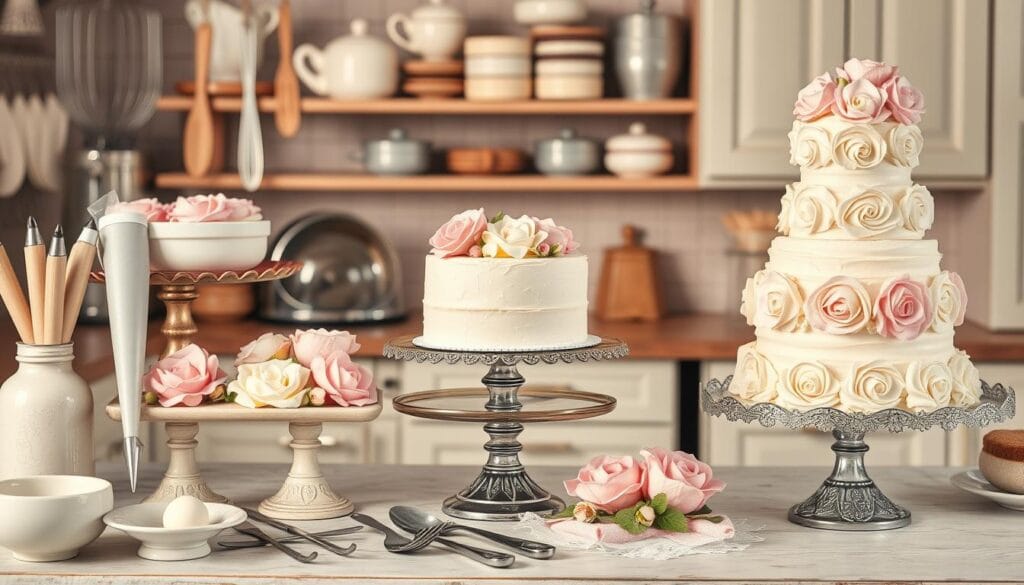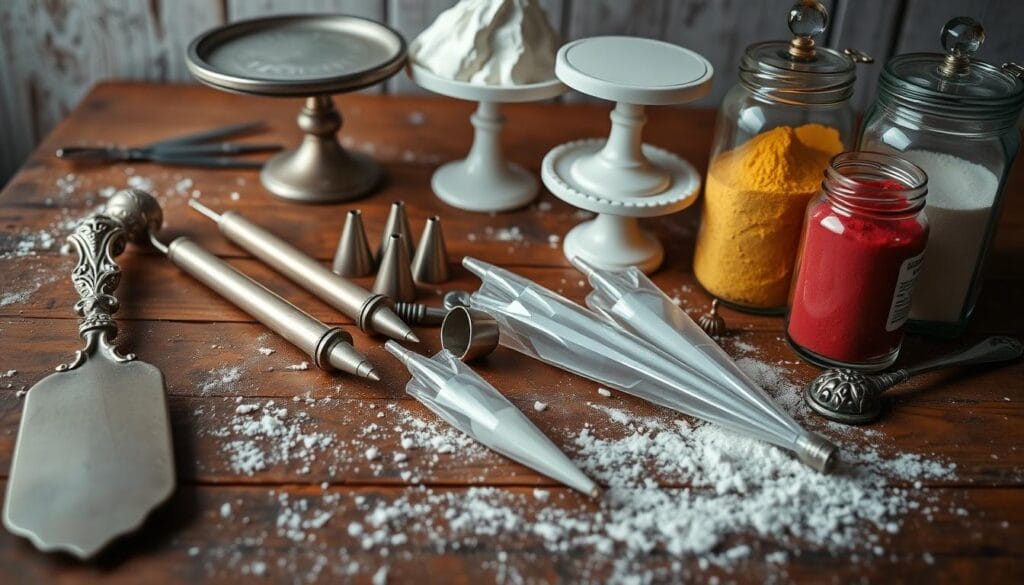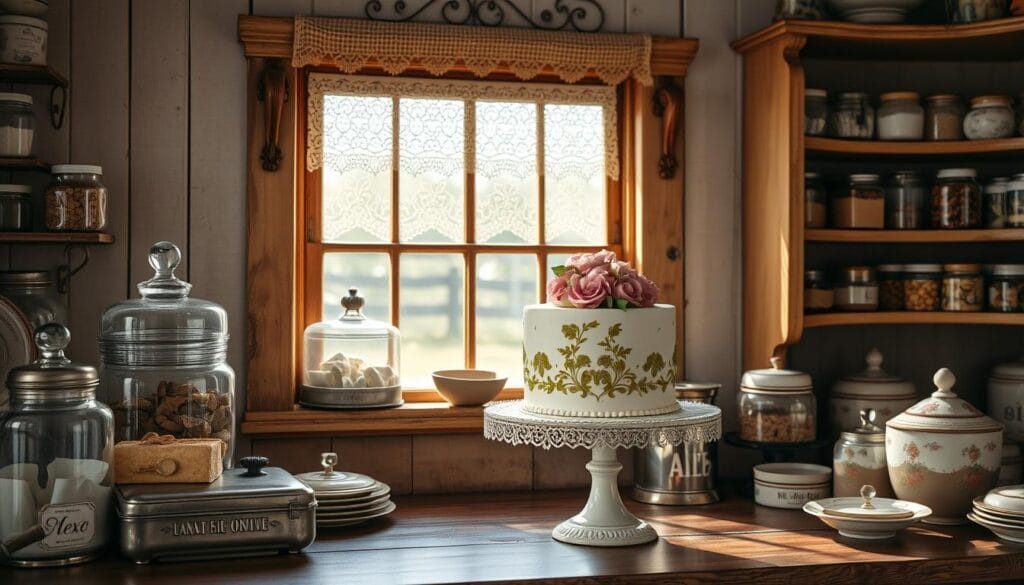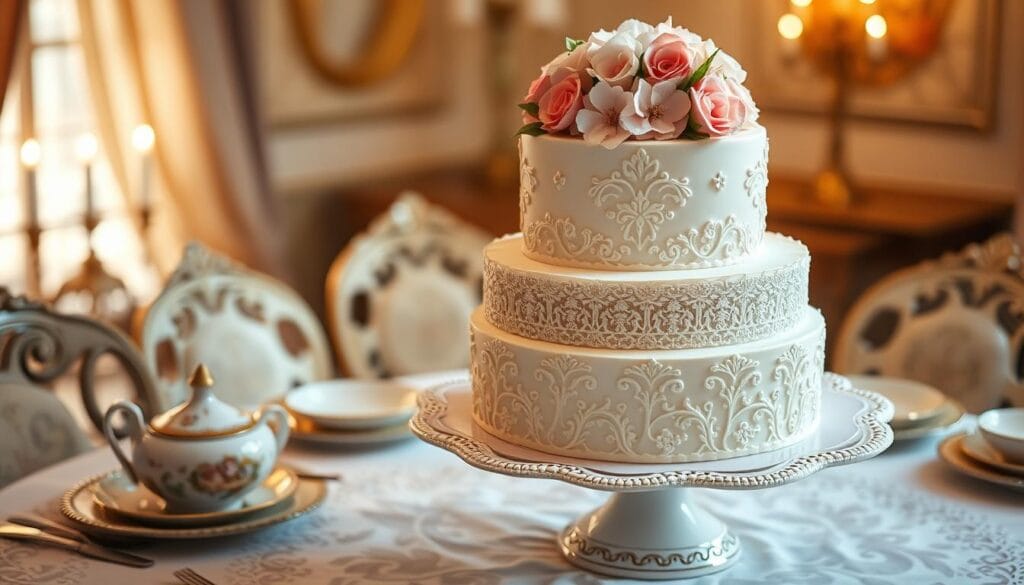Have you ever had a slice of cake that made you think of your grandmother’s kitchen? Vintage cakes are more than desserts. They’re edible memories that connect us through taste and design. In 2024, these classic cakes are loved by bakers and Instagram fans, adding elegance to today’s celebrations.
Retro desserts celebrate our culinary past. They range from the light Victoria sponge cake to the rich Southern Italian cream cake. These recipes share stories of family and culture. Starting your baking journey here, you’ll find these cakes are more than treats—they’re cherished moments.
Looking to make your event special? Vintage cake recipes are perfect. They mix old techniques with new styles, making every slice a masterpiece. It’s a treat for your eyes and taste buds.
Key Takeaways
- Vintage cakes represent more than desserts—they’re culinary memories
- Classic cake designs continue to inspire modern bakers
- Traditional recipes connect generations through shared experiences
- Vintage cake techniques blend historical craftsmanship with contemporary styles
- Each cake tells a unique cultural and familial story
The History and Evolution of Vintage Baking
Vintage baking is a journey through culinary traditions. It shows how old-fashioned sweets have evolved. The roots of traditional cake flavors go back to times of great change and innovation.
The Victorian era was a turning point for baking. It brought new techniques that changed how we bake today. Pioneers of that time introduced methods that made home cooking easier and more exciting.
Origins in Victorian Era
In the 19th century, baking saw big changes. Some key innovations were:
- Alfred Bird’s invention of baking powder
- Mrs. Beeton’s detailed cooking guide
- New ways to use refined sugar
“Baking is an art that connects generations through taste and tradition.” – Culinary Historian
Impact of Afternoon Tea Traditions
Afternoon tea, started by the Duchess of Bedford, changed how we enjoy cakes. It made cakes a big part of social gatherings. This trend spread all over the world.
| Era | Cake Characteristics | Social Significance |
|---|---|---|
| Victorian Period | Elaborate sponge cakes | Social gathering centerpiece |
| Early 20th Century | Simpler home-style recipes | Family bonding |
Rise of Home Baking Movement
The home baking movement let people try traditional cake flavors. Amateur bakers started making antique cake designs. They kept culinary traditions alive while adding their own twist.
Over time, these vintage baking methods have inspired today’s pastry chefs. They connect old recipes with new tastes.
Essential Ingredients for Traditional Cake Making
Starting your journey in vintage cake making means knowing the key ingredients. These components turn simple recipes into amazing desserts. They are the heart of bakery heritage.
“Baking is about passion, precision, and preserving culinary traditions” – Julia Child
Classic cake ingredients are the base of every great dessert. Let’s look at the must-haves for vintage baking:
- Flour: All-purpose flour gives cakes their shape
- Sugar: Granulated sugar adds sweetness
- Butter: Unsalted butter makes cakes creamy
- Eggs: Fresh eggs help cakes rise
- Milk: Whole milk keeps cakes moist
For vintage cake making, you’ll need special tools too:
| Tool | Purpose |
|---|---|
| Stand Mixer | Consistent mixing and incorporating ingredients |
| Offset Spatula | Smooth frosting application |
| Piping Bags | Intricate decorative designs |
| Serrated Knife | Precise cake leveling |
Knowing these classic ingredients and tools will change your baking. It connects you to generations of home bakers. They loved making delicious memories.
Classic Vintage Cake Styles and Designs
Nostalgic baking brings to life the enchanting world of vintage cake designs. These designs have captivated bakers and dessert lovers for generations. They are more than just sweet treats—they’re edible works of art that tell stories of culinary tradition and creativity.
Victorian Piping Techniques
The Lambeth Method emerged as a pinnacle of cake decoration during the Victorian era. This technique transforms cakes into delicate canvases. They feature:
- Elaborate scrollwork
- Intricate floral designs
- Delicate royal icing details
Timeless Floral Patterns
Traditional cake flavors come alive through stunning floral motifs. These motifs elevate vintage cake designs. Bakers skillfully create remarkable decorations using:
- Hand-painted blossoms
- Piped sugar flowers
- Delicate botanical arrangements
Vintage Cake Architecture
Architectural elements define vintage cake structures. They showcase remarkable craftsmanship through:
| Design Element | Characteristic |
|---|---|
| Multi-tier Construction | Elegant layered presentations |
| Structured Decorations | Precise geometric patterns |
| Height and Dimension | Dramatic visual impact |
“Every cake tells a story of culinary artistry and cultural heritage.” – Vintage Baking Enthuasiast
These vintage cake designs continue to inspire modern bakers. They bridge generations through their timeless beauty and detailed craftsmanship.
Vintage Cake Techniques and Methods
Mastering old-fashioned sweets means learning the detailed techniques passed down through generations. The art of classic cakes is more than just mixing ingredients. It’s about keeping heirloom recipes alive with care and passion.

Traditional cake decorating needs special skills to turn simple desserts into stunning works of art. Professional bakers use several key techniques to create memorable vintage designs:
- Lambeth Method for detailed piping
- Royal icing applications
- Precise color layering techniques
- Careful temperature management
The Lambeth Method, started by expert cake decorators, uses special piping tips for elaborate designs. You’ll need patience and practice to get good at these techniques.
“Cake decorating is an art that connects us to culinary traditions of the past.” – Vintage Baking Experts
Choosing the right colors is key in vintage cake design. Soft pastels and rich jewel tones create stunning effects that take you back in time.
| Technique | Key Tools | Skill Level |
|---|---|---|
| Lambeth Piping | Wilton Tips 4B, 32, 102 | Advanced |
| Royal Icing | Specialized spatulas | Intermediate |
| Color Layering | Oil blend colors | Expert |
Your journey into vintage cake techniques requires dedication. Practice these methods to create breathtaking desserts that tell a story with every delicate decoration.
Traditional Southern Heritage Recipes
Southern baking is a treasure trove of traditions that have warmed hearts for ages. Classic Southern cakes share tales of family reunions, county fairs, and the art of cooking passed down through generations.
Italian Cream Cake Legacy
The Italian Cream Cake is a true Southern gem. It may have a European name, but it’s all about Southern flavors. It’s known for its light texture, crunchy pecans, and creamy frosting.
It combines European baking with Southern ingredients, making it a standout in Southern kitchens.
Devil’s Food Cake History
The Devil’s Food Cake made its debut in 1902. It’s a chocolate lover’s dream, with a deep, rich taste. It’s made with unsweetened cocoa, coffee, and buttermilk for that extra kick.
- Originated in early 20th century
- Known for intense chocolate flavor
- Uses unique ingredient combinations
Lane Cake Tradition
The Lane Cake is a Southern baking treasure with a long history. It started in a county fair in Columbus, Georgia. It became famous after Harper Lee mentioned it in To Kill a Mockingbird.
| Cake Feature | Description |
|---|---|
| Origin | Columbus, Georgia |
| Key Ingredients | Bourbon, dried fruits, meringue |
| Cultural Significance | Literary fame in Southern literature |
“These cakes are more than recipes – they’re edible memories of Southern hospitality and culinary craftsmanship.”
Decorating Tools and Equipment

Making beautiful vintage cakes needs special tools. These tools bring antique cake designs to life. Your journey in bakery heritage starts with the right equipment. It turns simple ingredients into culinary art masterpieces.
Key tools for vintage cakes include:
- Cast iron turntables for stable cake decoration
- Precision icing spatulas (straight and offset)
- Acrylic disks for achieving sharp cake edges
- Quality anodized cake pans from Fat Daddio
- Silicone piping bags for detailed work
Professional bakers say high-quality tools are key to vintage cake craftsmanship.
“The right tools transform baking from a simple task to an art form” – Classic Bakery Artisan
When picking your vintage cake decorating tools, think about more tools to improve your skills:
- Cake levelers for perfect horizontal cuts
- Cake boards for elegant presentation
- Embossing rollers for Victorian-era designs
- Specialized piping tips for traditional decorations
You don’t have to spend a lot on your vintage cake decorating toolkit. Many professional-grade sets have lots of tools. They include tips, spatulas, and accessories for stunning antique cake designs with confidence.
Special Occasion Vintage Cakes
Vintage cakes make any celebration unforgettable. They add a touch of nostalgia and elegance. This creates memories that last long, beyond just dessert.
Wedding Cake Traditions
Your wedding day is special, and so is your cake. Vintage wedding cakes have detailed designs that honor traditions:
- Tiered white designs symbolizing purity
- Delicate piping techniques reminiscent of Victorian craftsmanship
- Symbolic decorations representing love and commitment
Birthday Celebration Classics
Vintage cakes add charm to birthdays. They range from 1950s designs to 1980s ruffles. Each captures the spirit of its time.
| Decade | Cake Style | Unique Feature |
|---|---|---|
| 1950s | Pastel Layer Cake | Polka dot decorations |
| 1980s | Ruffled Birthday Cake | Bold color combinations |
Holiday Season Favorites
Holiday vintage cakes unite families with traditional recipes. From coconut cake at Christmas to Texas sheet cake at Thanksgiving, they make memories sweet.
“A vintage cake is more than a dessert; it’s a slice of family history.” – Baking Enthuasiast
When you order a vintage cake for your special day, keep in mind. Most bakeries need 3 days notice. Prices start around $135.00. Make your cake your own, to match your celebration!
Understanding Vintage Cake Storage and Preservation
Keeping classic cakes fresh is all about the right storage. Your treasured recipes need special care to keep their flavors and textures perfect. Baking lovers know that the right storage makes a big difference.

Different cakes need different storage plans. Here’s a guide to help you keep your vintage cakes fresh and tasty:
- Room Temperature Storage
- Best for most classic cakes
- Store in airtight containers
- Optimal freshness: 3-4 days
- Refrigeration Methods
- Extends cake shelf life
- Wrap tightly to prevent moisture loss
- Bring to room temperature before serving
- Freezing Techniques
- Ideal for long-term preservation
- Buttercream cakes can last up to 4 months
- Use multiple layers of plastic wrap
“The secret to preserving vintage cakes is understanding their unique characteristics and treating each recipe with respect.” – Baking Preservation Expert
Each cake type has its own storage needs. Oil-based sponge cakes stay moist for up to 7 days. Butter-based cakes might dry out faster. Ganache cakes can be refrigerated for a week and frozen for months.
| Cake Type | Room Temp Storage | Refrigeration | Freezing |
|---|---|---|---|
| Buttercream Cake | 3-4 days | 5-7 days | Up to 4 months |
| Ganache Cake | 2-3 days | Up to 1 week | Several months |
| Cream Cheese Frosted | 2 days | 3-4 days | Not Recommended |
Pro tip: To revive dry cakes, drizzle sugar syrup or warm individual slices. Your vintage cakes will appreciate the extra effort!
Modern Twists on Classic Vintage Recipes
Retro desserts are back in style, thanks to modern bakers. They mix old baking methods with new flavors and looks. This way, they keep traditional recipes alive while meeting today’s tastes.
Today’s bakers are making classic cakes exciting again. They add new ingredients and techniques to old favorites. This gives beloved cakes a fresh twist.
- Matcha-infused Victoria sponge cake
- Lavender-enhanced pound cake
- Vegan adaptations of classic layer cakes
- Gluten-free vintage recipe variations
“Innovation in baking is about respecting tradition while embracing creativity.” – Pastry Chef Elena Rodriguez
Here’s a look at how modern bakers update classic cakes:
| Classic Recipe | Modern Interpretation | Unique Twist |
|---|---|---|
| Traditional Pound Cake | 7UP Pound Cake | Carbonated beverage infusion |
| Angel Food Cake | Chiffon Variation | Lighter texture, exotic flavors |
| Southern Lane Cake | Alcohol-Infused Gourmet Version | Sophisticated flavor profile |
By updating old recipes, bakers share classic tastes with new fans. They keep baking traditions alive while adding a modern touch. This way, they honor the past while appealing to today’s palates.
Conclusion: Preserving Timeless Baking Heritage
Vintage cake recipes are more than tasty treats. They connect us to our past, linking generations through shared moments and baking traditions. By exploring classic cakes, you’re not just baking—you’re keeping a cultural story alive.
By embracing heirloom recipes, you connect with old baking ways and add your own twist. Recipes from the 1960s and 1950s each have their own story. Sharing these recipes brings forgotten traditions back to life.
Your efforts are key in keeping this baking heritage alive. Share your family’s recipes, tell the stories behind each cake, and try new takes on old favorites. Vintage baking is about more than taste—it’s about the memories and bonds it forms.
As baking evolves, these timeless recipes remind us of our roots. They spark creativity, start conversations, and keep our food culture rich. Your dedication to these recipes ensures vintage baking will continue to enchant and inspire others.
FAQs
A cake is considered vintage if it features old-fashioned recipes, classic flavors, and traditional techniques that were popular in past decades, typically from the early to mid-20th century. Vintage cakes often have a nostalgic, retro aesthetic, with simple yet elegant designs. The ingredients and methods used may reflect those found in the pre-packaged, convenience-driven cake era, emphasizing homemade, scratch-baked creations.
Vintage cakes are commonly topped with frostings like buttercream, whipped cream, or royal icing. Buttercream is especially popular for vintage cakes, often made with a simple mix of butter, powdered sugar, and vanilla, giving it a smooth and creamy texture. For a more nostalgic touch, some vintage cakes may feature boiled frostings, such as seven-minute frosting, which is a fluffy, meringue-like topping.
Vintage cakes can be referred to by many names, depending on their specific style or era. Common terms include “classic cakes,” “retro cakes,” or “old-fashioned cakes.” Some vintage cake varieties are named after the specific cake style, such as layer cakes, fruitcakes, or chiffon cakes, which were popular in earlier decades.
Cowboy cakes are hearty, rustic cakes that were often made by cowboys or pioneers. These cakes are typically simple, robust, and made with ingredients that were easy to store and transport, such as flour, sugar, eggs, and dried fruits or nuts. They often have a spiced or cinnamon flavor and might be baked in a skillet or cast-iron pan. Cowboy cakes can also be referred to as “cowboy coffee cakes” or “cowboy bundt cakes,” depending on the style.

